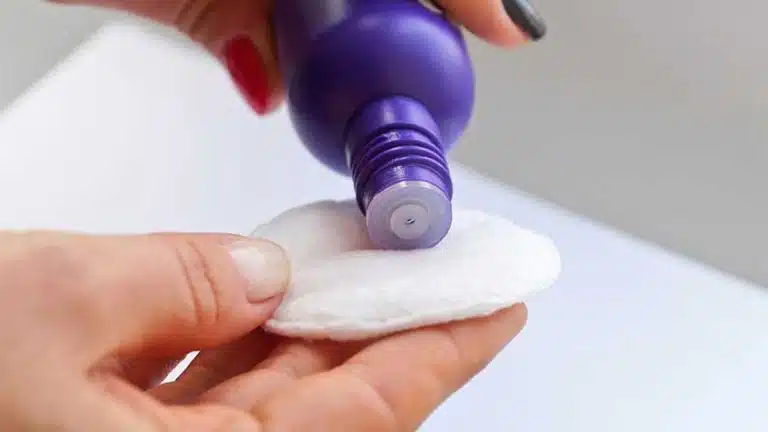Acetone Poisoning & The Dangers Of Drinking Nail Polish Remover

Because nail polish remover often contains alcohol, some people drink it. While the product can indeed get you drunk, it also poses serious health risks. That’s because it has highly toxic ingredients, including acetone.
Acetone belongs to a group of compounds called ketones, which are made by your liver when it breaks down fats. In addition to nail polish remover, acetone appears in numerous other household products, including rubbing alcohol, furniture polish, and some glues.
In most cases, accidental ingestion of a small amount of acetone won’t cause health problems. However, intentionally drinking nail polish remover or other products that contain acetone can lead to acetone poisoning.
What Is Acetone Poisoning?
Acetone poisoning is a serious condition that occurs when your body contains too much acetone.
Common symptoms of acetone poisoning include:
- feeling drunk
- drowsiness
- fruity odor
- confusion
- nausea and vomiting
- stomach pain
- frequent need to urinate
- low blood pressure
- difficulty breathing
- slowed breathing rate
- loss of consciousness
If you or someone you know experiences these symptoms, call 911 or the National Poison Control Center at 1-800-222-1222. The dispatcher will gather important information, such as the amount of nail polish consumed and the age, weight, and symptoms of the person who consumed it.
The dispatcher will then tell you what to do. For very mild cases, the person who drank the nail polish remover may just need to rinse their mouth out with water. Other times, the person will need to be taken to a hospital.
Treatment
At the hospital, doctors will examine the person’s breathing rate, blood pressure, and other vital signs. They will then create a treatment plan. Depending on the person’s needs, treatment may include:
- oxygen, a breathing tube, or other types of breathing support
- intravenous fluids
- medications to treat symptoms like nausea and stomach pain
- gastric lavage (emptying the stomach via a tube placed through the nose or mouth into the stomach)
Along with acetone poisoning, drinking nail polish remover can lead to acetone addiction.
What Is Acetone Addiction?
Acetone addiction is a serious condition that makes you feel unable to stop consuming acetone. The most common symptoms are tolerance and physical dependence.
Tolerance means that over time, your body gets used to the effects of acetone. You will then need increasingly larger or more frequent amounts of the substance to feel the desired effects. This greatly raises your risk of acetone poisoning.
Physical dependence means your body starts depending on acetone to function normally. If you stop using it, you may experience withdrawal symptoms such as:
- irritability
- mood swings
- poor memory
- trouble concentrating
- trouble sleeping
- sweating
- nausea and vomiting
If you think you or someone you know is addicted to acetone, seek help at an addiction treatment program.
Acetone Addiction Treatment
Addiction treatment programs offer a variety of services to help you stop using acetone, including:
- medical detox, in which doctors help you manage withdrawal symptoms as you stop drinking acetone
- mental health counseling, in which a therapist helps you manage acetone cravings and any underlying mental health concerns that may have led you to drink acetone in the first place
- support groups, in which you can discuss your experiences with other people recovering from substance abuse and addiction
Upon entering the addiction treatment program, you will likely be evaluated for alcohol addiction. That’s because many people who are addicted to alcohol drink nail polish remover when alcohol is not available.
Like acetone addiction, alcohol addiction can be treated with medical detox, counseling, and support groups. Some treatment plans also include medications designed to reduce alcohol cravings and withdrawal symptoms.
Other Dangers Of Drinking Nail Polish Remover
Besides acetone poisoning and addiction, other risks of drinking acetone include:
- burning in the mouth and/or esophagus
- liver damage
- kidney damage
- nerve damage
- birth defects if you drink acetone while pregnant
Acetone is not the only toxic substance in nail polish remover. Other dangerous ingredients include:
Butyl Acetate
Butyl acetate belongs to a group of organic compounds called esters. It can cause:
- irritation of the eyes, nose, throat, and lungs
- skin rash
- dizziness
- lightheadedness
- headache
- loss of consciousness
Dimethyl Formaldehyde
Dimethyl formaldehyde is a colorless gas that can cause:
- headache
- stomach pain
- nausea and vomiting
- dizziness
- constipation
- liver damage
- increased risk of cancer
Ethyl Acetate
Ethyl acetate is an ester that can cause:
- irritation of the eyes, nose, throat, and lungs
- dry, cracked skin
- dizziness
- lightheadedness
- loss of consciousness
- liver damage
- kidney damage
Toluene
Toluene belongs to a group of organic compounds called hydrocarbons. It can cause:
- irritation of the eyes and nose
- drowsiness
- dizziness
- headache
- anxiety
- confusion
- trouble sleeping
- liver damage
- kidney damage
- nerve damage
If you or a loved one abuses nail polish remover or any other substance, please reach out to an Ark Behavioral Health specialist. Our substance abuse recovery programs offer personalized, evidence-based treatments on an inpatient and outpatient basis.
Written by Ark Behavioral Health Editorial Team
©2024 Ark National Holdings, LLC. | All Rights Reserved.
This page does not provide medical advice.
Centers for Disease Control and Prevention - Preventing Adverse Health Effects from Exposure to: Dimethylformamide (DMF)
Centers for Disease Control and Prevention - Toluene
National Library of Medicine: MedlinePlus - Acetone poisoning
New Jersey Department of Health and Senior Services - Hazardous Substance Fact Sheet: n-BUTYL ACETATE
New Jersey Department of Health and Senior Services - Hazardous Substance Fact Sheet: ETHYL ACETATE
New Jersey Department of Health and Senior Services - Hazardous Substance Fact Sheet: ISOPROPYL ACETATE

Questions About Treatment?
Ark Behavioral Health offers 100% confidential substance abuse assessment and treatment placement tailored to your individual needs. Achieve long-term recovery.
100% confidential. We respect your privacy.
Prefer Texting?
Our friendly support team is here to chat 24/7. Opt out any time.







 Learn More
Learn More








